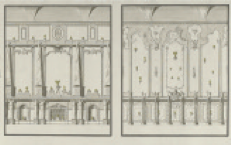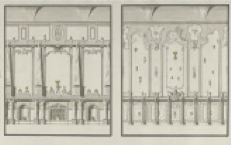Pablo Bronstein
Metropolitan Museum, New York
Pablo Bronstein, (b. 1977, Buenos Aires, currently London-based) is the six artist to participate in a series of solo shows of young artists presented annually by the Metropolitan Museum, New York, which has featured, since 2005, Tony Oursler, Kara Walker, Neo Rausch, Tara Donovan and Raqib Shaw. Bronstein has shown in London and Turin, and it is admirable that he should have his first one-man show in the USA at this museum.

Adopting the guise of the researcher and the architect, Bronstein explores a variety of historical periods and artistic practices − partic- ularly the French mannered Baroque and Neoclassic styles − to re- create them in drawings, installations and books. His vision of histo- ry appears to be cyclic, for already entering the 21st century, his appropriations and commentaries include, besides the mentioned periods, the strategies and pastiches of Postmodernism perceived through a historicist gaze; his work refers the viewer to the aesthet- ics of appropriations and “revivals”, highlighting that the baroque taste for excess and the new appreciation of ornamentation have been characteristic reac- tions against the rationality and the canons of “good taste” of Modernism.
For this occasion, the artist exe- cuted a series of seven large imaginary architectonic draw- ings that depict episodes of a mythical history of the Metropolitan Museum of Art itself, accompanied by a series of computer drawings articulating hypothetical futures of the Museum. The former include a view − impressive in its dimensions − of the Met’s façade under construction, as if it had been built all at once, which does not correspond to the reality of its construction in differ- ent stages and throughout different decades, resulting in the build- ing’s current appearance; another large drawing describes the imag- inary transportation and arrival of the great Egyptian Temple of Dendur at the Museum along the Fifth Avenue, reminiscent of a great imperial Napoleonic parade; also included is a drawing of two instal- lations from the collection of pre-Columbian works not devoid of humor on account of their hybrid quality, since both are reorganiza- tions of wall objects featuring Neo-Classic ornamentations.
In these drawings, Bronstein utilizes his historicist references not only to convey his commentaries regarding the ideologies of the styles and periods of the history of art, but also to indicate, ambiguously, on the one hand his admiration for the visual rich- ness, showiness and endeavors of the great European museums, which he shares with the U.S. institutions that have adopted them as models, and on the other hand, to criticize the ideological implications and power structures required to generate the the- atricality of these architectonic spaces. This analysis of institu- tional excesses and optimistic and expansionist trends contrasts with the series of smaller digital drawings, which, through tech- niques that are far from heroic − in the manner of cheap, present- day planes of development − feature a fictitious history of the future, a hypothetical archaeological reality of decadence, aban- donment and ruin, which refers us to the possibilities of the cur- rent economic situation; they include a view of the very nation- alistic American Wing, including the sculpture court, the Museum’s most recent addition, invaded by a tropical jungle. Bronstein’s work is inspired by, and makes clever allusions to, 18th century engravers, particularly Giovanni Battista Piranesi, (Venice, 1720- Rome, 1788), who developed in an imaginative way the popular genre of the “vedute”, prints of “architectonic views” that highlighted the charms of the city; this great defender of the eclec- tic Roman aesthetic as opposed to the idealistic Greek one, created highly whimsical compositions of fantastic worlds, an antecedent of the romanticist nostalgia for the beauty of abandoned ruins. Bronstein’s works revive this genre from the perspective of the 21st century, presenting solid conceptual considerations.





